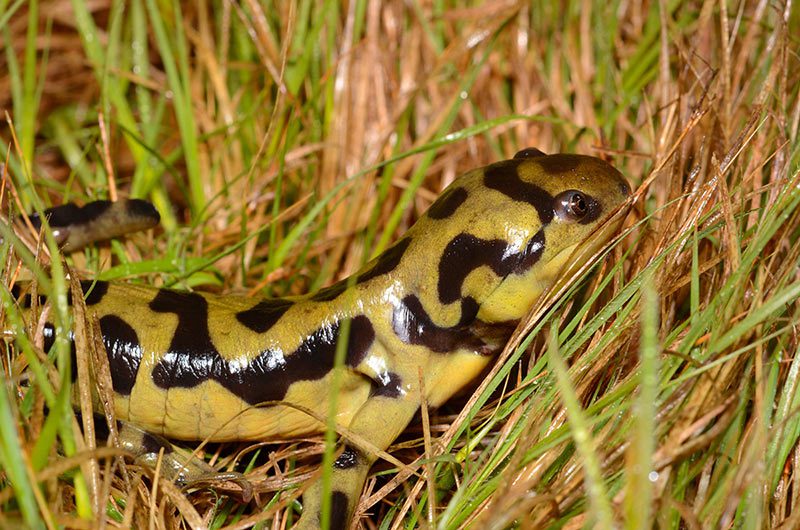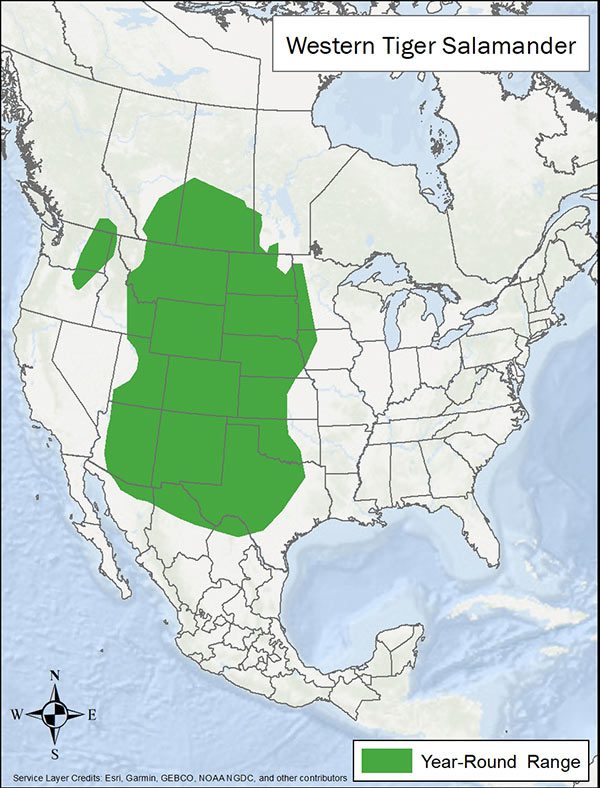LandPKS Learning
Habitat Hub

Western Tiger Salamander
Some tiger salamander larvae become cannibalistic and prey on their own kind for survival. Additionally, not all larvae metamorphose into tiger salamander adults. Instead, they remain aquatic over winter and become capable of producing offspring.
Ambystoma mavortium
Identification
The Western tiger salamander is a locally abundant amphibian that inhabits the Western United States and into southern parts of Canada. It measures 6-8 in/ 15-20 cm long and weighs 1 oz/ 29 g. The body of the salamander is dark with varying irregular shaped splotches that range from a yellow to greenish color. Western tiger salamander larvae are aquatic, have three pairs of gills and are a dark green to brown color.
Observation Tips
The Western tiger salamander is hard to find because adults spend most of their time in burrows below ground and emerge when migrating to bodies of water to breed. Western tiger salamander lay eggs in masses of approximately 100 eggs attached to debris in bodies of water. Migration to breeding sites usually occurs soon after precipitation events and at night.
Interesting Fact
Some tiger salamander larvae become cannibalistic and prey on their own kind for survival. Additionally, not all larvae metamorphose into tiger salamander adults. Instead, they remain aquatic over winter and become capable of producing offspring.
Ideal Habitat
Western tiger salamanders prefer loose soil (silty clay loam, sandy clay loam, or loam) for burrowing and nearby water bodies usually within 656 ft/200 m. Burrows are made by salamanders or made by rodents or other animals. Tiger salamanders lay eggs in still or slow-moving water including seasonal pools, lakes, or intermittent streams. Larvae hatch and feed on aquatic invertebrates, insect larvae, and sometimes other tiger salamander larvae. Adult tiger salamanders feed on insects, worms, and snails. They will inhabit almost any terrestrial vegetation as long as it is close to appropriate breeding habitat.

Range map provided by International Union for Conservation of Nature
Management Activities that Benefit Species – Best Management Practices (BMPs)
Maintain intact native vegetation around breeding ponds. Protect and maintain wetlands by preventing sedimentation, degradation, and drainage through fencing livestock away from ponds, wetlands and streams. The construction of artificial ponds can be successful in providing habitat for the salamanders to breed. Provide livestock water access points or alternative off-channel water development (tanks) to benefit salamanders by protecting most or all of the shoreline or streambanks.
Management Activities to Avoid
Avoid introducing nonnative predatory fish into breeding ponds. Avoid habitat fragmentation when constructing new roads and trails. Additionally, water contamination negatively impacts larval survival. Avoid water pollution to breeding ponds including runoff from agricultural fields and livestock containment areas. Agricultural runoff contaminating ponds with nitrogen can increase bacteria or raise acidity in the water decreasing salamander offspring survival.
Other Species that Benefit from Similar Habitat Management
Other species that benefit from similar management include other salamanders, frogs, and other species that rely on isolated water bodies and are vulnerable to predatory fish.
Download
Download the western tiger salamander factsheet
Other Resources
International Union for Conservation of Nature (IUCN). 2014. The IUCN Red List of Threatened Species. Version 2021-1 Western tiger salamander
Montana Field Guide: Western tiger salamander
NatureServe: 2021. NatureServe Explorer: An online encyclopedia of life [web application]. Version 7.1. NatureServe, Arlington, Virginia. Western tiger Salamander
Photo credit: Andrew DuBois/Flickr
Mobile App | Data Portal | Knowledge Hub | Habitat Hub | Learning Collections | Blog | About | Contact | Support



